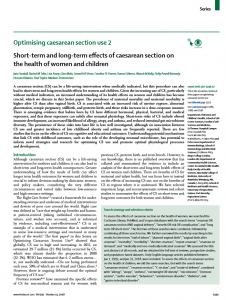
A caesarean section (CS) can be a life-saving intervention when medically indicated, but this procedure can also lead to short-term and long-term health effects for women and children. Given the increasing use of CS, particularly without medical indication, an increased understanding of its health effects on women and children has become crucial, which we discuss in this Series paper. The prevalence of maternal mortality and maternal morbidity is higher after CS than after vaginal birth. CS is associated with an increased risk of uterine rupture, abnormal placentation, ectopic pregnancy, stillbirth, and preterm birth, and these risks increase in a dose–response manner. There is emerging evidence that babies born by CS have different hormonal, physical, bacterial, and medical exposures, and that these exposures can subtly alter neonatal physiology. Short-term risks of CS include altered immune development, an increased likelihood of allergy, atopy, and asthma, and reduced intestinal gut microbiome diversity. The persistence of these risks into later life is less well investigated, although an association between CS use and greater incidence of late childhood obesity and asthma are frequently reported. There are few studies that focus on the effects of CS on cognitive and educational outcomes. Understanding potential mechanisms that link CS with childhood outcomes, such as the role of the developing neonatal microbiome, has potential to inform novel strategies and research for optimising CS use and promote optimal physiological processes and development.
—
Caesarean section—the most common surgery in many countries around the world—is a procedure that can save women’s and babies’ lives when complications occur during pregnancy or birth. However, caesarean section use for non-medically indicated reasons is a cause for concern because the procedure is associated with considerable short-term and long-term effects and health-care costs. Caesarean section use has increased over the past 30 years in excess of the 10–15% of births considered optimal, and without significant maternal or perinatal benefits. A three-part Lancet Series on Optimising Caesarean Section Use reviews the global epidemiology and disparities in caesarean section use, as well as the health effects for women and children, and lays out evidence-based interventions and actions to reduce unnecessary caesarean sections.
Access the 1st paper of the Lancet series – Global epidemiology of use of and disparities in caesarean sections
Access the 3rd paper of the Lancet Series – Interventions to reduce unnecessary caesarean sections in healthy women and babies
Access the 1st Comments paper about the series – FIGO position paper: how to stop the caesarean section epidemic
Access the 2nd Comments paper about the series – Appropriate use of caesarean section globally requires a different approach
Access the 3rd Comments paper about the series – Strategic measures to reduce the caesarean section rate in Brazil
Access the Editorial paper about the series – Stemming the global caesarean section epidemic
Access the Profile paper related to the series – Ana Pilar Betrán: seeking the optimum use of caesarean section